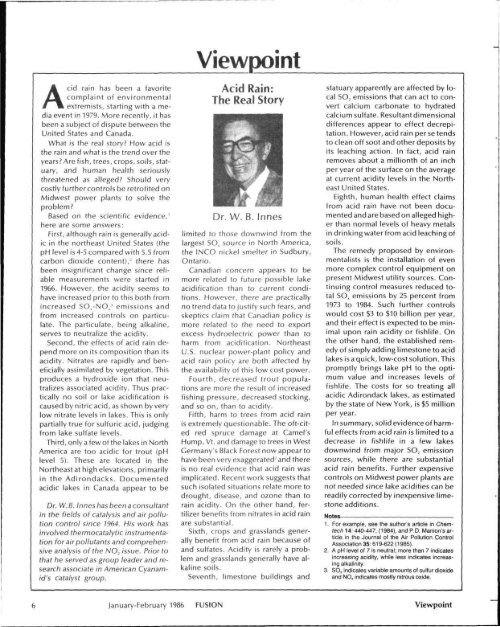And Hypersonic Flight
And Hypersonic Flight
And Hypersonic Flight
Create successful ePaper yourself
Turn your PDF publications into a flip-book with our unique Google optimized e-Paper software.
Acid rain has been a favoritecomplaint of environmentalextremists, starting with a mediaevent in 1979. More recently, it hasbeen a subject of dispute between theUnited States and Canada.What is the real story? How acid isthe rain and what is the trend over theyears? Are fish, trees, crops, soils, statuary,and human health seriouslythreatened as alleged? Should verycostly further controls be retrofited onMidwest power plants to solve theproblem?Based on the scientific evidence, 1here are some answers:First, although rain is generally acidicin the northeast United States (thepH level is 4-5 compared with S.5 fromcarbon dioxide content), 2 there hasbeen insignificant change since reliablemeasurements were started in1966. However, the acidity seems tohave increased prior to this both fromincreased SO,-NO„ J emissions andfrom increased controls on particulate.The particulate, being alkaline,serves to neutralize the acidity.Second, the effects of acid rain dependmore on its composition than itsacidity. Nitrates are rapidly and beneficiallyassimilated by vegetation. Thisproduces a hydroxide ion that neutralizesassociated acidity. Thus practicallyno soil or lake acidification iscaused by nitric acid, as shown by verylow nitrate levels in lakes. This is onlypartially true for sulfuric acid, judgingfrom lake sulfate levels.Third, only a few of the lakes in NorthAmerica are too acidic for trout (pHlevel 5). These are located in theNortheast at high elevations, primarilyin the Adirondacks. Documentedacidic lakes in Canada appear to beDr. W.B. Innes has been a consultantin the fields of catalysis and air pollutioncontrol since 1964. His work hasinvolved thermocatalytic instrumentationfor air pollutants and comprehensiveanalysis of the N0 2 issue. Prior tothat he served as group leader and researchassociate in American Cyanamid'scatalyst group.ViewpointAcid Rain:The Real StoryDr. W. B. Inneslimited to those downwind from thelargest SO, source in North America,the INCO nickel smelter in Sudbury,Ontario.Canadian concern appears to bemore related to future possible lakeacidification than to current conditions.However, there are practicallyno trend data to justify such fears, andskeptics claim that Canadian policy ismore related to the need to exportexcess hydroelectric power than toharm from acidification. NortheastU.S. nuclear power-plant policy andacid rain policy are both affected bythe availability of this low cost power.Fourth, decreased trout populationsare more the result of increasedfishing pressure, decreased stocking,and so on, than to acidity.Fifth, harm to trees from acid rainis extremely questionable. The oft-citedred spruce damage at Camel'sHump, Vt. and damage to trees in WestGermany's Black Forest now appear tohave been very exaggerated 2 and thereis no real evidence that acid rain wasimplicated. Recent work suggests thatsuch isolated situations relate more todrought, disease, and ozone than torain acidity. On the other hand, fertilizerbenefits from nitrates in acid rainare substantial.Sixth, crops and grasslands generallybenefit from acid rain because ofand sulfates. Acidity is rarely a problemand grasslands generally have alkalinesoils.Seventh, limestone buildings andstatuary apparently are affected by localS0 2 emissions that can act to convertcalcium carbonate to hydratedcalcium sulfate. Resultantdimensionaldifferences appear to effect decrepitation.However, acid rain perse tendsto clean off soot and other deposits byits leaching action. In fact, acid rainremoves about a millionth of an inchper year of the surface on the averageat current acidity levels in the NortheastUnited States.Eighth, human health effect claimsfrom acid rain have not been documentedand are based on alleged higherthan normal levels of heavy metalsin drinkingwaterfrom acid leaching ofsoils.The remedy proposed by environmentalistsis the installation of evenmore complex control equipment onpresent Midwest utility sources. Continuingcontrol measures reduced totalSO, emissions by 25 percent from1973 to 1984. Such further controlswould cost $3 to $10 billion per year,and their effect is expected to be minimalupon rain acidity or fishlife. Onthe other hand, the established remedyof simply adding limestone to acidlakes is a quick, low-cost solution. Thispromptly brings lake pH to the optimumvalue and increases levels offishlife. The costs for so treating allacidic Adirondack lakes, as estimatedby the state of New York, is $5 millionper year.In summary, solid evidence of harmfuleffects from acid rain is limited to adecrease in fishlife in a few lakesdownwind from major S0 2 emissionsources, while there are substantialacid rain benefits. Further expensivecontrols on Midwest power plants arenot needed since lake acidities can bereadily corrected by inexpensive limestoneadditions.Notes1. For example, see the author's article in Chemtech14:440-447, (1984), and P.O. Manion's articlein the Journal of the Air Pollution ControlAssociation 35:619-622 (1985).2. A pH level of 7 is neutral; more than 7 indicatesincreasing acidity, while less indicates increasingalkalinity.3. SO„ indicates variable amounts of sulfur dioxideand NO„ indicates mostly nitrous oxide.6 January-February 1986 FUSION Viewpoint
















